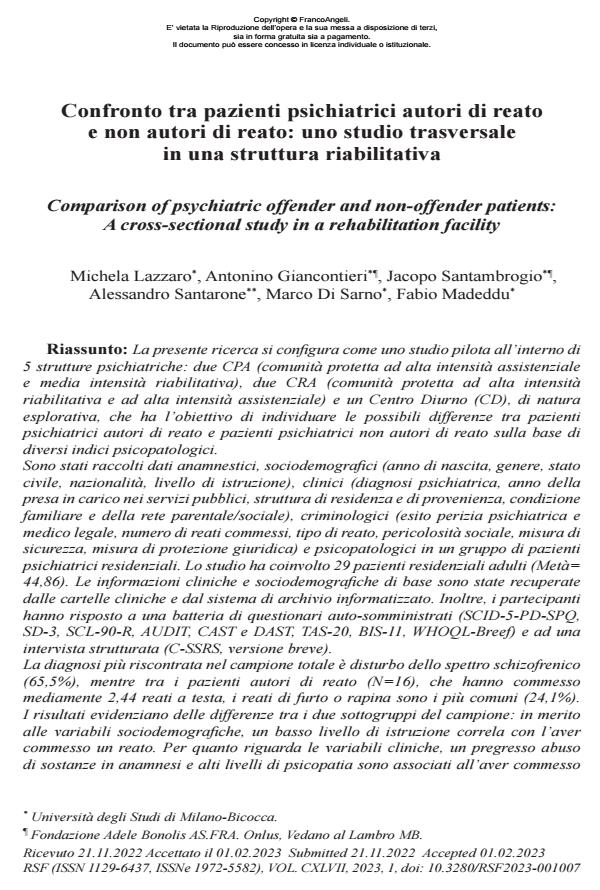Confronto tra pazienti psichiatrici autori di reato e non autori di reato: uno studio trasversale in una struttura riabilitativa
Journal title RIVISTA SPERIMENTALE DI FRENIATRIA
Author/s Michela Lazzaro, Antonino Giancontieri, Jacopo Santambrogio, Alessandro Santarone, Marco Di Sarno, Fabio Madeddu
Publishing Year 2023 Issue 2023/1
Language Italian Pages 21 P. 103-123 File size 213 KB
DOI 10.3280/RSF2023-001007
DOI is like a bar code for intellectual property: to have more infomation
click here
Below, you can see the article first page
If you want to buy this article in PDF format, you can do it, following the instructions to buy download credits

FrancoAngeli is member of Publishers International Linking Association, Inc (PILA), a not-for-profit association which run the CrossRef service enabling links to and from online scholarly content.
The present study is in the form of a pilot study in 5 psychiatric structures: two CPA (Protected Community with High Assistance Intensity and Medium Rehabilitation Intensity), two CRA (Protected Community with High Rehabilitation Intensity and High Assistance Intensity) and a Day Center (CD), exploratory in nature, aimed at identifying possible differences between psychiatric offender and non-offender psychiatric patients on the basis of various psychopathological indices. Sociodemographic (year of birth, gender, marital status, nationality, level of education), clinical (psychiatric diagnosis, year of intake into public services, residence and home facility, family and parental/social network status), criminological (psychiatric and forensic expert outcome, number of confirmed offenses, type of offense, social dangerousness, security measure, legal protection measure) and psychopathological data were collected in a group of psychiatric residential patients. The study involved 29 adult residential patients (Mean age=44.86). Baseline clinical and sociodemographic information was retrieved from medical records and the computerized archival system. In addition, participants answered a battery of self-administered questionnaires (SCID-5-PD-SPQ, SD-3, SCL-90-R, AUDIT, CAST and DAST, TAS-20, BIS-11, WHOQL-Breef) and a structured interview (C-SSRS, short version). The most common diagnosis in the total sample is schizophrenic spectrum disorder (65.5 percent), while among patient offenders (N=16), who committed an average of 2.44 offenses each, theft or robbery offenses were the most common (24.1 percent). The results show differences between the two sample subgroups: regarding sociodemographic variables, a low level of education correlates with having committed a crime. Regarding clinical variables, a past history of substance abuse and high levels of psychopathy are associated with having committed a crime, while personality traits and/or internalizing symptoms are more pronounced in the non- offender group, suggesting that they might act as a protective factor for criminal behavior.
Keywords: Offending psychiatric patients, non-offending psychiatric patients, risk ad protective factors of violence, psychopathology.
Michela Lazzaro, Antonino Giancontieri, Jacopo Santambrogio, Alessandro Santarone, Marco Di Sarno, Fabio Madeddu, Confronto tra pazienti psichiatrici autori di reato e non autori di reato: uno studio trasversale in una struttura riabilitativa in "RIVISTA SPERIMENTALE DI FRENIATRIA" 1/2023, pp 103-123, DOI: 10.3280/RSF2023-001007